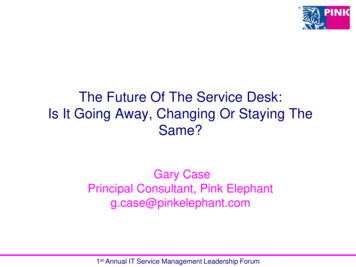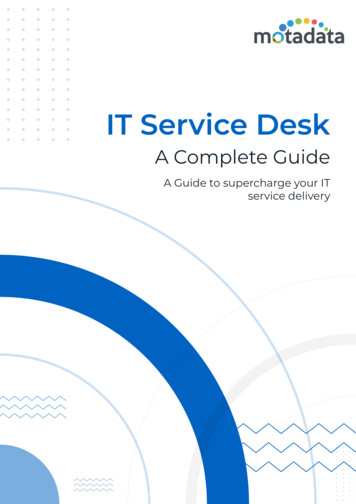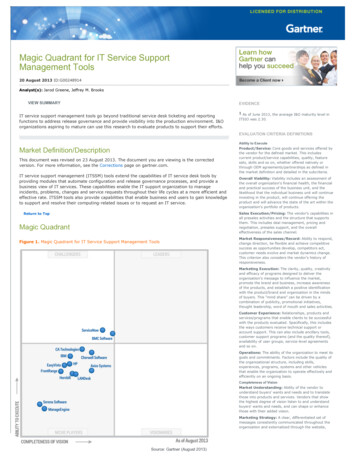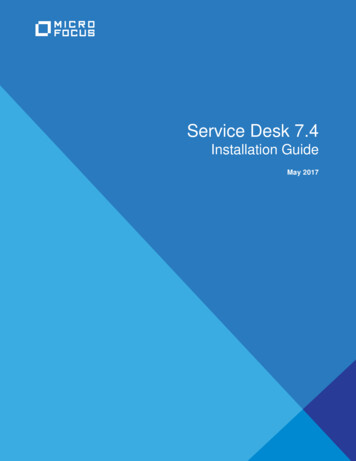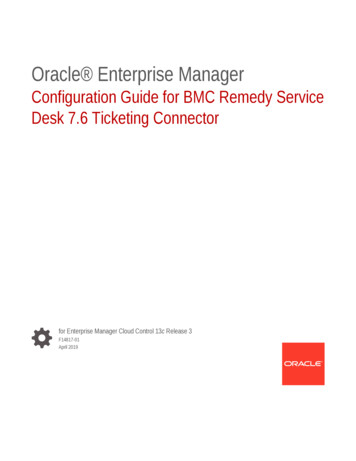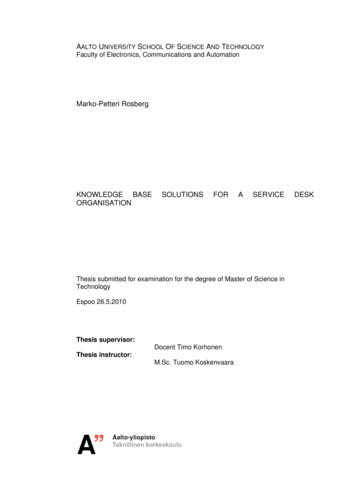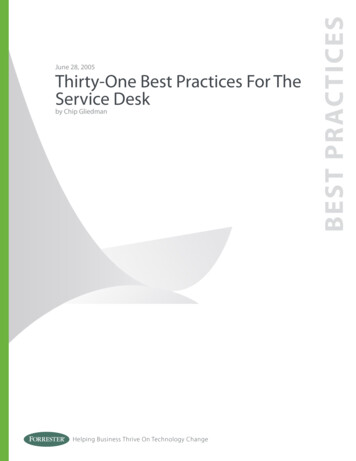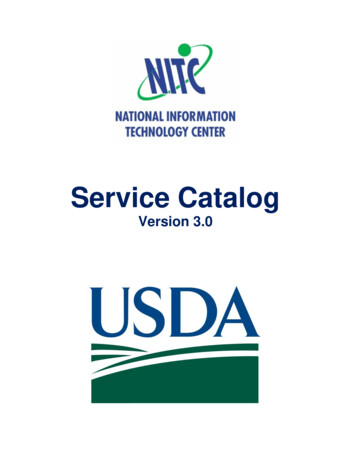
Transcription
White paper The future of Service Desks - visionWhite paperThe future of Service Desks - visionService Desks require strategic consideration and innovation to raise user productivity and to support businessgoals. Fujitsu has the experience and feedback from the market which put us in a privileged position to createthe vision of a Service Desk which is available anywhere, anytime and via any platform.ContentIntroductionBackgroundFujitsu’s ApproachOur VisionBring Your Own Device (BYOD)Email ticket submissionSupport systems that automatically know the userSupport systems that automatically identify the userSelf-healing and self-aware machines and softwareSmarter peer-to-peer supportService Desk Virtual agentsTailor-made and target-orientedAttrition and people developmentPrioritization, classification and optimization of ticketsSelf-service portalsFinal ThoughtsPage 1 of vices/infrastructure/service-desk/
White paper The future of Service Desks - visionIntroductionService Desks are generally accepted as the main customer interfaceand often as the single ‘touch point’ where users can receive help andguidance on IT service issues, problems and requests - hence itsimportance.However, very few organizations see the Service Desk as a servicewhich requires longer-term strategic consideration and innovation andthis is one of the areas where Fujitsu differentiates itself from itscompetitors.Companies increasingly depend on IT technology and business successis closely linked with IT innovation. This leads to ever-changingrequirements for Service Desks. Fujitsu believes that it is essential tolook beyond the next 12-24 months and develop a long-term visionfor Service Desks that is based on the society, organization andtechnology changes that will continue to affect the way in which wemust deliver support.BackgroundThe continued growth and adoption of mobile smart devices includingBring Your Own Device (BYOD), social media technology and newcloud solutions result in constantly changing expectations andopportunities for an IT Service Desk.In the past, Service Desks predominantly received calls about something that was broken. Now, demands from end users increasinglyinclude requests based on “I need to” or “how can I do this” whichrequire a fundamentally different approach and skills set. Organizations are also demanding more agile, flexible, innovative and cheapersolutions to meet their rapidly changing business needs. The currenteconomic climate is also forcing companies to re-evaluate theirexisting systems and strategies with a clear focus on increased servicedelivery at a lower cost while maximizing the use of existing resources.This is a great opportunity for the Service Desk of the future.Moving forward, end-user self-service portals and seamless integrationwith mobile devices are the key directions for IT service technology.Employees want to access services and support when they want,where they want, using whichever technology and device. This cancreate problems for IT professionals trying to manage such a widerange of technology infrastructure; but this is reality and IT companiesneed to adapt accordingly.So the future Service Desk must be able to provide services via webportals using any browser technology and via any device, thusenabling users to access the services they need. Another high priorityis a reduction of expensive and time-consuming solution developmentresources.Page 2 of ture/service-desk/
White paper The future of Service Desks - visionFujitsu’s ApproachFujitsu is working to anticipate the challenges and changes thatcompanies are likely to face and this White Paper describes a vision ofa Service Desk that we will be seeing in 2020. It identifies key areas ofchange and how Service Desks should develop in the coming years tomeet future challenges.Predicting the future is impossible and we cannot reliably forecast thefuture of Service Desks. However, as a result of our experience, ourinnovative thinking and also by understanding our market andlistening to customer feedback we believe that we are in a privilegedposition to forecast some of the future requirements, trends andinnovative ideas and that a fair percentage of these predictions will becorrect.Many market experts have identified over the last couple of years thatthere is a growing demand for Service Desks to deliver and demonstrate a greater contribution and value to the operation of thebusiness for which they work. Fujitsu identified and highlighted thismore than 10 years ago and since then we have been implementingideas, processes, methods and technologies that have made us as aleader in this sector. Every year Fujitsu spends about 2.5 billion onR&D and some of this money goes into Service Desk innovation.Many companies that have not invested in Service Desk innovationnor provided significant value via their Service Desk services haveclosed down their operations or are in the process of closing whereasothers, such as Fujitsu, who continuously invest in delivering greaterbusiness value, are growing. Following our vision of a human-centricintelligent society, Service Desk innovation is and will be an importantelement in raising user performance and satisfaction in the comingyears.Our VisionOur vision for Service Desk 2.0 is Anywhere, Anytime and on AnyPlatform.The Service Desk of the future will operate anywhere, anytime and onany operating system or platform. Service Desk agents and users willno longer be restricted to a particular location or technology in orderto deliver or receive fast and efficient technical support. Virtual agentswill be a part of all Service Desks in the not so distant future and theywill complement or in some cases replace human agents.Employees are already spread all over the world and are mobile. Theycan access company tools from anywhere in the world using theirfavorite apps on their own preferred devices (BYOD). Service Desksmust adapt to such changes in order to keep pace and ensure thattheir employees and clients are efficient, effective and motivated.Here are some of the measures that we believe will be trend-setting ina medium to long-term Service Desk strategy and which will bring realinnovation: Bring Your Own Device (BYOD)Email ticket submissionInstant Messaging technologySupport systems that automatically know the userSupport systems that automatically identify the user.Self-healing and self-aware machines and software.Peer-to-peer supportService Desk Virtual agentsTailor-made and target-orientedAttrition and people developmentPrioritization, classification and optimization of ticketsSelf-service portalsAnother crucial role of the Service Desk is to act as a facilitator for costsavings by preventing failures in technology and associated servicesfrom having a negative impact on business. Again, this can only beachieved by innovation.Page 3 of ture/service-desk/
White paper The future of Service Desks - visionBring Your Own Device (BYOD)BYOD is on the rise and set to drastically increase over the next fewyears. Organizations must face the fact that employees want to useand indeed will use their own devices for work. They are already doingso. Service Desks need to be prepared and adapt to meet this trend.Some companies are embracing BYOD as a way of increasing theproductivity of their workforce while others are not so open to theidea, mainly due to security concerns.It is a key factor for Fujitsu that boundaries are clearly stated andunderstood and that employees have to follow the standards,procedures and guidelines involved when connecting their device tothe company network. The Service Desk needs to understand andcommunicate the level of support that is provided to employees whobring their own devices. The Service Desk as well needs to have clearunderstanding and clear criteria and procedures for BYOD todetermine what is supported by internal IT, what is supported by athird party and what is the responsibility of the employee. The call isthen handled accordingly.Email ticket submissionEmail is often seen by end-users as a faster way to log a ticket becausethey do not want to spend time on the phone. However, email ticketsin reality usually take longer to get closed. This is due to users’inability to troubleshoot a particular situation or describe their need inthe original request whereas a Service Desk agent on the phoneknows exactly which questions must be asked in order to solve theproblem quickly. Nevertheless, we must accept that many users preferto email a ticket rather than call the Service Desk.Fujitsu has seen email growing as a channel for users to reportincidents from 10% in 2005 to 25% in 2013. We predict this trend willcontinue over the next few years even though the increase speed willdrop.In order to process email ticket submissions efficiently and effectivelysystems must be able to automatically route tickets based on theemail content so that the entire process is turned into an automatedprocess instead of fully people-based. This will revolutionize the wayemail tickets are handled. Fujitsu is already implementing and furtherdeveloping this innovative concept.Page 4 of 8Instant Messaging technologyIn general, Instant Messaging is easy to deploy. It requires no orhardly any training and it is very quick. In many cases users alreadyuse one form or another of Instant Messaging in their private life.It thus has some advantages in a Service Desk context. There arehowever several aspects to consider before implementing “normal”Instant Messaging technologies as part of a Service Desk. Companiesneed to think about how this channel is to be managed and whatbenefits this technology generates as there will be more complexrequirements and considerations associated.Fujitsu has seen Instant Messaging technologies grow as a channel forusers to report incidents from 2% in 2005 to 10% in 2013. We predictthat this trend will continue over the next few years.Although it may be possible for Service Desk agents to manage one ormore Instant Message conversations at one time, this method ofhandling questions will lose its appeal if a Service Desk agent is slowor non-responsive in an Instant Message conversation. For thischannel to be successful It is also vital to understand how servicelevels, ticket volumes and user satisfaction can be monitored,measured and reported. Any Instant Messaging technology musttherefore be fully integrated into the ticketing tool.As with other more standard Service Desk interfaces, it is often thehuman element that is the bottleneck (searching for answers, typingthe reply and often duplicating the call or text in a ticketing tool inless integrated systems). The future of Instance Messagingtechnologies for Service Desks undoubtedly lies in automated repliesor bots. Artificial intelligence needs to be embedded in InstantMessaging technology allowing users to submit and troubleshoot aproblem in normal language (for example English). A bot would replywith valid intelligent solutions to the problem. Chat bots are alreadyreality and can provide a great service compared to a human operator:much faster, cheaper and more reliable in some cases. This requires acomprehensive knowledge base that continually improves and whichis in constant evolution as more and more tickets are created.Research here is already underway and will undoubtedly be reality,thus generating a revolution in the Instant Messaging ticketingsubmission rastructure/service-desk/
White paper The future of Service Desks - visionSupport systems that automatically know the userA user has been to the company’s intranet several times trying to finda solution for a specific IT problem. If unsuccessful, that user willprobably pick up the phone and call the Service Desk. By the time theuser has identified himself via the automated voice system (or wasautomatically identified – see below), the Service Desk will know thatthe user has been to the intranet and the pages he has visited. Thiswill stop similar suggestions being made or asking whether the userhas found and tried certain solutions which are offered via thoseintranet pages. This will increase user satisfaction tremendously. Withsuch detailed information about users and their historic data in termsof tickets the Service Desk proactively identifies user trends, suggeststraining requirements, changes intranet pages and providesinformation for IT departments.The Service Desk knows the profile of the user calling, and whetherthat person is technically skilled enough to self-serve most of the timeor whether this user requires more detailed troubleshooting assistance. If the user calling the desk has comprehensive technical skills,the Service Desk automatically assumes that this call should bedirected to a 2nd level support stage. This technology already existsbut has not been widely adopted.Support systems that automatically identify the userFujitsu has invested a lot of effort in biometric systems. Smart systemscan use retina scans, palm scans and other real-time personal information in order to ensure that when someone contacts the ServiceDesk the agent automatically receives this information in order toidentify the person. This reduces time, saves money and avoids thefrustration of having to repeat information again and again. The samecould be applied to the Service Desk agent receiving the request. Theuser automatically knows to whom he is talking.If we can envisage what this technology enables, we can immediatelyunderstand its importance. Here is a simple example. A user calls theService Desk to request a new laptop. The agent knows who the useris, his department, his manager, who has to approve this request andthe process to order, setup and deploy this laptop. This completeinformation will ultimately be available without having to consultdifferent systems. We could list many examples where such technology can save time, money and incredibly increase the efficiency of acompany that is supported by a Service Desk.This technological advance will bring its own set of unique challenges(privacy, security, etc.) but will undoubtedly become reality in thefuture for all Service Desks. Fujitsu already has the technology requiredto support this.Page 5 of 8Self-healing and self-aware machines and softwareAs machines become increasingly connected to the internet and otherdevices they can solve their own problems or at least alert owners, ITdepartments, or even the devices that they have a problem. This iscritical in companies with thousands of devices; Service Desks could bewarned of any problems affecting any device in the company.In most companies today, a user or a group of users calls the ServiceDesk agents who then realize that there is a problem and reactivelyinform IT. This is basically how companies usually find out that theyhave an issue with one of their systems.Alerts created automatically when there are failures enable the ServiceDesk to contact the user proactively. A solution can be simultaneouslyprovided or a hardware change or other intervention can be triggeredwhich solves the problem - hopefully without the user even noticingsomething has happened. It is easy to imagine the positive impact ofsuch proactive measures on productivity and end-user satisfaction.Today, such work is already carried out by several software systems(anti-virus software, etc.), informing the user that there is a need foran update. However, most hardware still depends on a personnoticing a problem and asking for a solution. Unfortunately, theperson using the device is the one who alerts the Service Desk.Smarter peer-to-peer supportSometimes the best solution for a very specific problem does not comefrom the IT department, a manual or a knowledge base and maybenot even from the Service Desk but from someone in the companywho has experienced a similar technical situation or problem.Peer-to-peer support is not the right solution for every problem but itis sometimes the best possible - and perhaps fastest and cheapest support available. The Service Desk should have mechanisms to directthe user to the right person; this can only be done with the right toolsand processes.An increasing number of companies are recognizing that peer-to-peersupport is essential and saves money. It also engages customers in acompany’s community and provides better support than any trained ITperson can do. The need for desk-side engineers is greatly reducedand employees reach out to each other in order to establish bettercooperation within a company. Incentives can even be put in place tofoster such behavior. The Service Desk plays a key role in this approachby redirecting the question to the appropriate colleague if they haveinnovative information systems to facilitate such rastructure/service-desk/
White paper The future of Service Desks - visionService Desk Virtual agentsA virtual agent is a computer-generated character that simulates aconversation to deliver interactive voice or text-based information in aService Desk or customer care environment. Virtual agents can provideaccurate, personalized, fast, interactive information to customers viawebsites, phones, social media sites and instant messaging applications. When properly designed, deployed, and managed the ServiceDesk Virtual agent can hold an intelligent conversation with end-usersand thus provide a very efficient method for ticket resolution.Today’s most capable Service Desk agent “toolsets” are still somewhatcomplex to build, customize and operate. Fujitsu is investing heavilyinto this technology and we believe that the not so distant future willsee self-learning Adaptive Intelligence Service Desk agents capable ofhandling highly complex interactions. Companies will be able toleverage this technology in order to accurately replicate real humanconversations and end-users will obtain the answer to their questionsalmost instantly and precisely.Deploying virtual agents to perform simple “first touch” tasks is alreadypossible and the near future will see these agents answering increasingly complex questions; such offered self-help based saves on morecostly support resources. These Service Desk Virtual agents will replacesome of the standard human operators in all Service Desks in thefuture; they will need the following abilities: Automatic learning Recording and reporting Base personalities Profiling Management and optimizationTailor-made and target-orientedFor Fujitsu the Service Desk is designed to be fit-for-purpose, suitingthe unique needs of a specific organization and its customers ratherthan adopting the exact model used elsewhere. The Service Deskneeds to feel like part of the company – a fact of which Fujitsu is fullyaware. Metrics should drive desired behaviors in a balanced way andbased on our experience we are able to suggest changes and improvements to contracts and metrics if we believe they make more sense orcreate a viable alternative that still delivers a great service but atlower cost.Fujitsu understands our customers’ businesses and their targets andthe Service Desk has to be a facilitator supporting companies to meetand exceed their objectives. Companies use Service Desks becausethey help them achieve their targets. We keep this in mind, considering how our actions impact them and demonstrate that everythingwe do is focused on helping organizations to achieve establishedgoals.Page 6 of 8Attrition and people developmentEvery company understands the importance of attrition and peopledevelopment but why are they so important for the Service Desk andwhat can be done to innovate?The Service Desks’ position within many companies is at the bottom ofthe decision chain. It is usually something for employees to do beforemoving onto another role. Fortunately, this perception is changing not just because of the increasingly high caliber of professionals thatthe industry is attracting but also because of the innovation factor incompetent Service Desk companies which transforms a sometimesrepetitive task into a much more rewarding experience. MotivatedService Desk employees have a big positive impact on the organizations they support since they continue to look for ideas on how toimprove the service. If you just imagine the number of interactionseach Service Desk agent has with your staff you can easily understandthe importance of this element.Prioritization, classification and optimization of ticketsThis is another area which Fujitsu believes will be crucial in the future.We have already seen - and are using - smart-learning algorithms forweb-based content (Google search and others) but what about aticketing tool that discovers the importance of a ticket based on thewords and data it contains, and which thus effectively turns the entirecontrol of the process into a semantic method instead of fullyuser-based. Tickets get escalated, routed, prioritized and archivedbased on their actual content rather than human choice. This savestime and money, reduces mistakes, increases user satisfaction andoffers a much better end-to-end service. Ticket documentation,indexing and searches also increase dramatically which is critical forany Service Desk performance.Self-service portalsSelf-service portals and knowledge bases are two essential requirements for the Service Desk of the future. They are the ideal tools toresolve simple incidents and service requests quickly; they are alsoone of the most cost-effective ways to provide 24 7 customer support.They are readily accessible and ease the demand on support teams bymaking essential information available automatically and effortlessly.Other self-help tools, such as FAQs, how-to guides, videos, andinternal forums, can also reduce the impact of routine work and after awhile users become used to such elements. These elements can beintegrated or embedded into Self-Service Portals.Self-service portals can be much more than just a one-stop shop forticket submissions and updates, they can proactively inform the userof important matters taking place in the company. Organizationsshould take advantage of this mechanism to connect with employees.The Service Desk of the future must implement robust self-serviceresources to facilitate the resolution of repetitive tier-one problems. Itmust also promote rvices/infrastructure/service-desk/
White paper The future of Service Desks - visionFinal ThoughtsService Desks will always be needed because IT breaks, IT does thingsthat it shouldn’t do and IT users do not know how to do things or howto get the information they need. So it is safe to assume that ServiceDesks will still exist in ten or twenty years’ time, in fact, they will bethriving but will undoubtedly be different.Service Desks will still be required until self-healing software andhardware have become reality and eliminate 100% of the issues in away that does not affect workers, and all applications areself-explaining and all interfaces are unrestrictedly intuition.Page 7 of 8IT is evolving quickly although the pace of this evolution has sloweddown recently which is quite understandable but there will be otherleaps forward in the near future. The more technologies we introduce,the more complex the systems are. Company processes and competition between companies are forcing us to adapt quickly. A ServiceDesk can be a differentiator for companies and a way for employees tobe more productive.Perhaps some of the predictions in this White Paper will not come trueand they are simply futuristic thoughts. Others will seem reallyobvious when we look back on them in five or ten years’ time. The keyis to consolidate and then innovate, ensuring that we have the rightbase on which to build and this is an area that Fujitsu has been strongover the structure/service-desk/
White paper The future of Service Desks - visionContactFUJITSUFujitsu Technology Solutions GmbHAddress: Mies-van-der-Rohe-Straße 8, 80807 Munich, GermanyE-mail: cic@ts.fujitsu.comWebsite: www.fujitsu.com2014-04-01 INT ENPage 8 of 8ƒ 2014 Fujitsu Technology Solutions GmbHFujitsu, the Fujitsu logo are trademarks or registered trademarks of Fujitsu Limited in Japan and othercountries. Other company, product and service names may be trademarks or registered trademarks of theirrespective owners. Technical data subject to modification and delivery subject to availability. Any liability thatthe data and illustrations are complete, actual or correct is excluded. Designations may be trademarks and/orcopyrights of the respective manufacturer, the use of which by third parties for their own purposes mayinfringe the rights of such structure/service-desk/
Our vision for Service Desk 2.0 is Anywhere, Anytime and on Any Platform. The Service Desk of the future will operate anywhere, anytime and on any operating system or platform. Service Desk agents and users will no longer be restricted to a particular location or technology in order to deliver or receive fast and efficient technical support.

